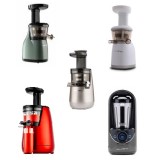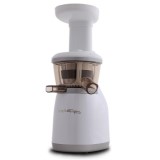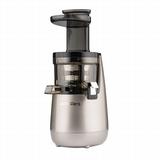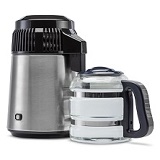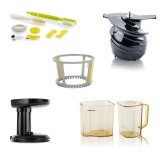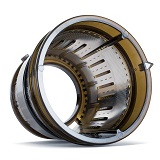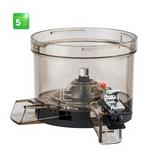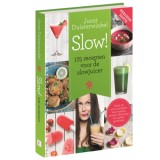Frequently Asked Questions
We receive many questions daily and tried to work them out in this overview. Please find your answers here or get in touch with us via email or phone. Of course we are happy to receive your questions.
4 Your Versapers Slowjuicer
The 1G (First Generation) slowjuicers of Versapers can be recognized by the totally free juice outlet. With the 2G version a ‘small screen’ in the juice outlet prevents objects or fingers to be put in. In addition, the fine strainer of the 1G is white, while the color of the fine strainer of the 2G is orange or yellow. The 3G has a juice cap at the juice outlet. And the gear at the bottom of the bowl is opposite the two outlets of the pulp and the juice (and not directly in front of them). On the page 'which generation slowjuicer do I have' the differences are explained further.
Suppose, you need a new strainer when you want to replace the bowl. Please note how old and which type your Versapers slowjuicer is. If you have a White or Chrome version, bought before August 2010, then you have a 1G and you need the upgrade/replacement kit. The new strainer won't fit into your former bowl. If your slowjuicer is more recent, then you can exchange the strainer independently from the bowl. This is also the case when you have a Pearl or Titanium version. You can also order a fine strainer separately, no matter how old your slowjuicer is.
Read more about 'which generation slowjuicer do I have?'.
The fine strainer has fine meshes which hold bakc the fibers in the juice as much as possible, producing a smooth juice. Incidentally, also small parts of fiber get through the fine strainer when juicing fruits and vegetables rich in fiber. The fine strainer is mad of hard Ultem material, which makes it suitable for both soft and hard and fibrous fruits and vegetables.
The coarse strainer allows more fiber to get through, making the juice thicker. The coarse strainer which comes for free with the slowjuicer is made of less hard plastic. That is why this strainer is only suitable for soft fruits. With hard products it can break easily.
For people who want more, there are additional accessories such as a pulp sieve for velvety soft juice without fibers. Also, there is an Ultem coarse strainer which is suitable for all types of products. Look at this page for more information about the various strainers.
13 Problem Solving
The Versapers has a fine and a coarse strainer. If you want minimal fibers, use the fine strainer. Some products, such as pineapple, fennel or celery have from origin many small fibers in them. The fine strainer also allows some of these fibers to get through. It helps to enter the products at a gentle pace. At a faster pace, the strainer gets more full and the juice will aslo be squeezed through the upper ring. Because the upper holes of the strainer are slightly larger, fibers can get through more easily. An additional possibility is the pulp strainer. You can easily put this on the juice container, so the juice will get an extra filtering. This pulp sieve costs € 7,50 euro plus shipping and can be ordered through: http://versapers.nl/accessories/pulp-zeef.html
5 Cleaning and Maintenance
17 Use of Fruits and Veggies
Sometimes our customers experience difficulties when squeezing celery.
What is noticeable are the long fibers of the celery that are clinging to the screw and get stuck in the pulp exit. This is a known issue. We have many customers who like to squeeze celery. (often because they are enthusiastic about celery juice after reading Anthony Willams' book).
The problem then often lies in feeding long pieces of celery in the hopper. There are no knife blades in the Versapers and the screw just presses and bruises the vegetables. Because celery has a lot of hard fibers, these fibers become just pieces of rope that turn around the screw and get stuck in the pulp exit because they can not get around the sharp corner of the pulp exit. This will cause the pulp to not exit properly and get clogged up above. The pressure in the strainer and the bowl thus increases. This situation goes from bad to worse, the pressure increases but the pulp must go somewhere at some point. Then it eventually goes under and over the strainer and you end up with a juice full of pulp.
The best way to make it easy for your machine is to cut these fibers 0.5 - 1 cm very short. The shorter you cut it, the easier it is for the machine to process. So if you have a stalk of celery, cut the bottom off, then remove the individual stalks. Rinse each stalk clean and then put them back together on a large cutting board. Then chop the celery with a large sharp knife into "macaroni curves". Rather more fine than too coarse, but do what you can and are comfortable with.
If you work this way, the pulp output will flow much better and your juice will be of better quality even if you juice 3 whole bunches of celery. The same advice applies to all fibrous vegetables, such as fennel, ginger, dill or parsley stems etc. etc.






